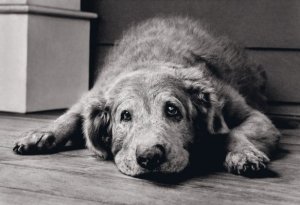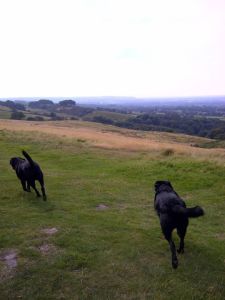A breed not many people have heard of the Spinone Italiano ! They have a fantastic temperment so below is some of the History!
Opinions vary widely concerning the origins of this dog. Some believe that he is descended from the same stock as the Setter and that climate alone has affected the development of his thick coat. However, since relatively ancient times, we find the Setter and the Spinone prevalent in the same areas, and for this reason this theory becomes untenable. Other commentators believe the Spinone to stem from the Coarsehaired Segugio, well known throughout the Piedmont. Nevertheless some writers claim that the Spinone was prevalent beyond the Piedmont, in Venetia, Dalmatia, Istria and as far as the Danube, which would support the theory that the Spinone came from the East.
Tale, a dog expert, states that about a hundred years ago the Roan Spinone, was especially well known in Lombardy and Venetia, and that this variety with longer hair than the classic Spinone and with silky hair on the ears and forehead is still extant. Although some experts are convinced that the Spinone is a cross with a Griffon, he is probably the true Spinone of the Julian and Graie Alps which, having come from Russia, later spread into Lombardy and Venetia. All this is in opposition to Tschudy’s statements, namely that during the Roman era the Setter was developed in Italy. The Italian Coarsehaired Setter had origins comparable to the Pointer in Italy, where Greek traders and others from the western Adriatic Coast brought Coarsehaired Setters in ancient times. The Coarsehaired Setter was called the Spinone. This breed was formed by cross breeding an imported Coarsehaired Setter and a white Mastiff of those already prevalent along the coasts of Italy.
In 1981 four Spinoni were imported by Mrs Mary Moore (Odivane) and from the progeny of these four dogs the breed was firmly established in the U.K. Owing to this increasing popularity, the Kennel Club granted the Spinone Championship status in 1994, i.e. in simple terms, removed their original classification as a Rare Breed. With Challenge Certificates now on offer at several shows during the year, the Spinone already has a number of Show Champions amongst its ranks. In his country of origin the Spinone is certainly not a Rare Breed, but an ancient and highly valued gundog in the custody of real breed enthusiasts. The Spinone’s working style is characterised by his wonderful fast trotting gait, which enables him to methodically hunt a large area. He is adaptable to any kind of ground, but is at his best in woods and marshland. With his thick skin and coarse coat, he will face any cover and is a strong and willing retriever from water.
All these qualities combined with his gentle nature make the Spinone a great companion for the rough shooter. The Spinone is distinguished by his markedly sweet and almost human expression – his demeanour is almost human too’ He thrives on companionship and can become somewhat despondent if left alone for too long. He is not a dog you can shout and scream at, but with a soft yet firm voice you will gain his respect. He has a wonderful memory of places and people and holds a special affinity with children. The Spinone is a country dog at heart, enjoying free exercise and having the stamina to work all day, but he will happily settle with the family by the fireside. In his first year, when obedience training and socialisation with other dogs and people is a must, he may be destructive and headstrong, but perseverance with gentle but firm training will produce positive results as he passes through adolescence around 18 months of age.
The Spinone enjoys his food and has been known to help himself if the situation arises! His strong scenting ability may occasionally lead him astray, both as a thief and as a hunter on his walks. Most owners see an improvement in the latter as their Spinone matures but generally little change in the former throughout his life. He can be prone to weight gain in maturity when regular and varied exercise is a must. A little larger than the average Retriever, the Spinone male can reach 27.5″ at the withers when mature, the females an inch or two less. The breed standard states 32 to 37 kgs as the weight margin of the male but in reality many exceed 40 kgs. So before rushing out to buy a Spinone you must ask yourself if your environment is suitable for a large dog. If you are still convinced that the Spinone is the breed for you, then take your time and view as many adult Spinoni as you can before being smitten by the appeal of young puppies.” Quoted from http://www.italianspinone.co.uk/
Italian Spinone Club of Great Britain – http://www.italianspinone.co.uk/
The local areas I work/ cover in is Romiley , Stockport , Woodley, Bredbury , Hyde , Gee Cross , Hazel Grove , Godley , Disley , Marple , Marple Bridge , Glossop , Poynton , Higher Poynton , New Mills , Hayfield , Whaley Bridge , Mellor. If you are not situated in one of these areas do not hesitate to contact me as other areas are considered. These do not apply for home boarding.
Aussie Dog Care Email : ATHOMPS1@sky.com
Aussie Dog Care Facebook : https://www.facebook.com/AussieDogCareUk for updates when you go away for peace of mind as well as some walking clients.
Aussie Dog Care Twitter : https://twitter.com/AussieDogCare
Aussie Dog Care
The Best Care For Your Furry Friends.
Tailoring to your needs










